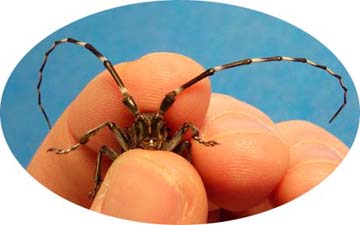
Asian
Longhorned Beetle
 |
Asian
Longhorned Beetle
|
 |
|
Research
|
 Eradication
of the Asian longhorned beetle (ALB) from the United States is the goal
of the US Department of Agriculture and other cooperating state
organizations where this exotic pest has been found infesting
trees. Several research projects have been initiated to improve
survey and detection methods that enhance the chance of successful
eradication. Should eradication prove unfeasible however, management
strategies are also being investigated. In addition, the potential impact
of ALB on the American landscape is being evaluated, including the
specific host range of this exotic pest in the US. An overview of much
of the ALB research is presented here, which has been compiled with the
cooperation of the scientists involved with this ongoing work. We will
update this section as additional information becomes available. Eradication
of the Asian longhorned beetle (ALB) from the United States is the goal
of the US Department of Agriculture and other cooperating state
organizations where this exotic pest has been found infesting
trees. Several research projects have been initiated to improve
survey and detection methods that enhance the chance of successful
eradication. Should eradication prove unfeasible however, management
strategies are also being investigated. In addition, the potential impact
of ALB on the American landscape is being evaluated, including the
specific host range of this exotic pest in the US. An overview of much
of the ALB research is presented here, which has been compiled with the
cooperation of the scientists involved with this ongoing work. We will
update this section as additional information becomes available.* Please note information on this page is prior to 2005 * |
|
|
| There is a critical need for information on the basic biology of the Asian longhorned beetle. This information is a vital component for the potential management (and hopefully eradication) of this pest. A number of scientists are currently studying the biology of ALB, from life cycles to host tree species. Below are some abstracts from these researchers. |
| Synthesis Report on Rearing Asian Longhorned Beetle (PDF) |
| Effects of Temperature on the Life History Parameters of Anoplophora glabripennis (Coleoptera: Cerambycidae) |
| Age-Specific Fecundity of Anoplophora glabripennis (Coleoptera: Cerambycidae) on Three Tree Species Infested in the United States (PDF) |
| Methods for Rearing the Asian Longhorned Beetle, Anoplophora glabripennis |
|
|
| The effectiveness of several commercially available chemical insecticides is currently under investigation. Though these compounds would not be appropriate for use in a maple forest used for producing maple syrup, they may be suitable for eradication or slowing the spread of this pest. Both systemic and topical insecticides are being tested. |
| Efficacy of Pesticides on the Asian Longhorned Beetle Anoplophora glabripennis |
| Toxicity and Efficacy of Imidacloprid to Anoplophora glabripennis (Coleoptera: Cerambycidae) |
| Evaluation of Systemic Insecticides to Control Anoplophora glabripennis (Coleoptera: Cerambycidae) |
|
Survey
and Detection
|
|
Efficient, reliable and cost-effective ALB detection methods are
essential for successful eradication. Currently detection of ALB is
limited to searching for infested tress by ground crews using
binoculars, tree climbers or inspectors aided by hydraulic lift
vehicles. Based on the experiences of the past 4 years, the experts
admit that early infestations are easily overlooked by inspectors who
check trees from the ground. Detection of infested trees is more likely
when inspectors are able to survey the upper canopy of the trees, but
this is expensive, and dangerous because of power lines, and depending
on the location of the tree sometimes impossible. Researchers are
currently developing acoustic detection technology that will enable
inspectors to determine if a tree is infested by “listening” for the
feeding sounds made by ALB. Research is also being conducted to isolate chemical attractants to trap ALB. They would serve as an important tool for evaluating the efficiency of surveys, but would not replace the need for surveys and tree inspection. Pheromones (odors given off by the beetle to that attract other beetles) and plant extracts are being investigated. An attractant trap would increase ALB detection and monitoring capabilities around infested areas, at ports and in warehouses. |
| Dispersal of Anoplophora glabripennis (Cerambycidae) (PDF) |
| Modeling Dispersal of the Asian Longhorned Beetle (PDF) |
| Acoustic Detection of Anoplophora glabripennis and Native Woodborers (Coleoptera: Cerambycidae) |
| Dispersal Potential of Anoplophora glabripennis Motsch. |
|
Semiochemicals of Anoplophora glabripennis, the Asian longhorned beetle (Coleoptera: Cerambycidae) |
| Aggregation Pheromone for the Asian Longhorned Beetle, Anoplophora glabripennis (Coleoptera: Cerambycidae) |
|
|
| ALB is a serious pest problem in China, where it causes significant economic loss in poplar plantations. So far all ALB infestations in the US have been found in suburban and urban environments. However, in the US where millions of acres of contiguous hardwood forests occur, the impact of ALB is unknown but could be devastating. This country represents a new environment for ALB with many different host tree species. Studies are underway to determine the host range of ALB in this country. This research will provide information to improve methods of survey and detection and enable a more comprehensive assessment of the economic and environmental impacts of a widespread infestation of this pest. |
| The Potential Effect of Asian Longhorned Beetle (Anoplophora glabripennis) on Urban Trees in the United States |
|
|
| Few natural biological controls are known for ALB in China. Because much of the life of ALB is spent protected within the tree, it is difficult for natural enemies to reach them. Surveys are underway to identify previously undiscovered beneficial insects or pathogens that could be developed for management. |
| BIOLOGICAL CONTROL OF ANOPLOHORA GLABRIPENNIS MOTSCH.: A SYNTHESIS OF CURRENT RESEARCH PROGRAMS |
| Infectivity of Rhabditoid Nematodes to the Asian Longhorn Beetle |
| Investigations of Natural Enemies for Biocontrol of Anoplophora glabripennis (Motsch.) |
|
|
Last Updated: 2005